Featuring reflections, a unique and interesting feeding technique and a takeoff.
We’ve actually had two days in a row of great weather and good light (can’t remember the last time that happened) and yesterday morning my shooting location of choice was Bear River MBR. For the second year in a row the refuge has chosen to drain the largest pond in Unit 2 right at the beginning of breeding season which severely restricts viewing opportunities for visitors, and breeding opportunities for birds, along the auto tour loop but I still had some good looks at a variety of bird species.
- When the refuge drained the same pond at the same time last year they said it was to facilitate some kind of construction project (replacing a water control structure I believe). But after it had been drained for weeks the refuge announced on their Facebook page that for some unknown reason they changed their minds about doing the construction project so they refilled the pond when it was too late for many birds to use the area for breeding. And now it looks like the entire process may be beginning again. I just don’t get it…
Ok, back to the avocets.
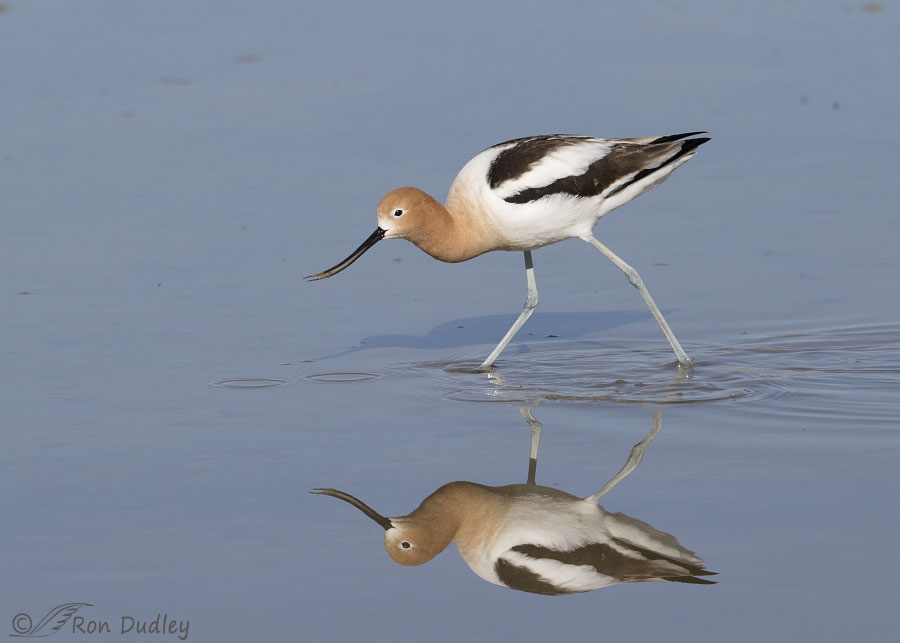
1/5000, f/6.3, ISO 400, Canon 7D Mark II, Canon EF 500mm f/4L IS II USM, not baited, set up or called in
American Avocets were a star attraction of my morning. This pond provided some areas of clear, clean water which in the absence of wind produced some nice reflections. This avocet was feeding and I caught it with a tiny invertebrate in its bill.
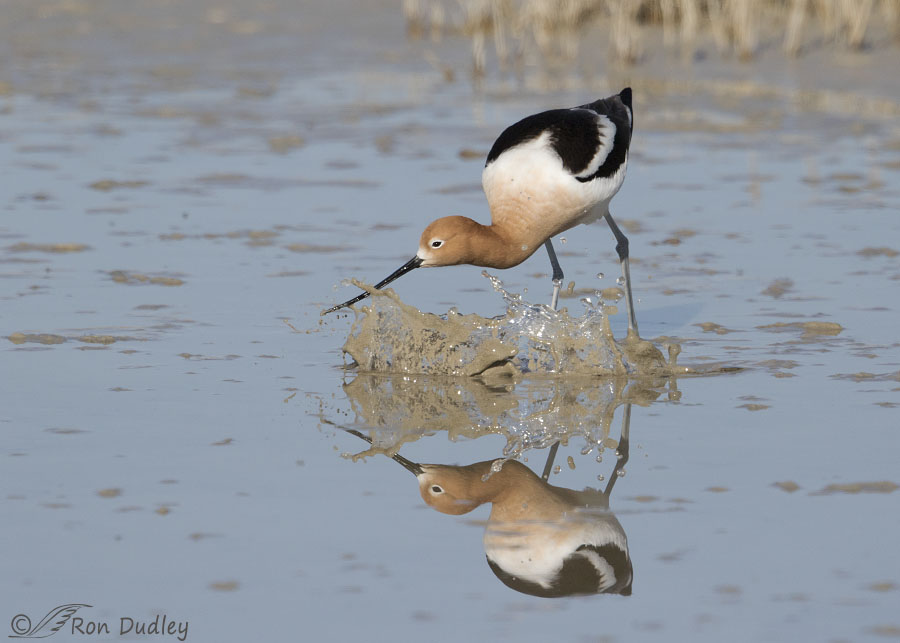
1/5000, f/6.3, ISO 400, Canon 7D Mark II, Canon EF 500mm f/4L IS II USM + EF 1.4 III Extender, not baited, set up or called in
Avocets use some distinctive and named feeding techniques; 3 of them are visual and 6 are tactile. This one is a tactile feeding method called Single Scything. While Single Scything is being used the bill is held slightly open at the shallow water’s surface and swept from side to side as the bird walks forward which throws up a unique and interesting sideways water splash.
- This is a commonly used avocet feeding method which makes me wonder if their distinctively recurved bill evolved its upward curve to facilitate the effectiveness of the behavior? Makes sense to me…
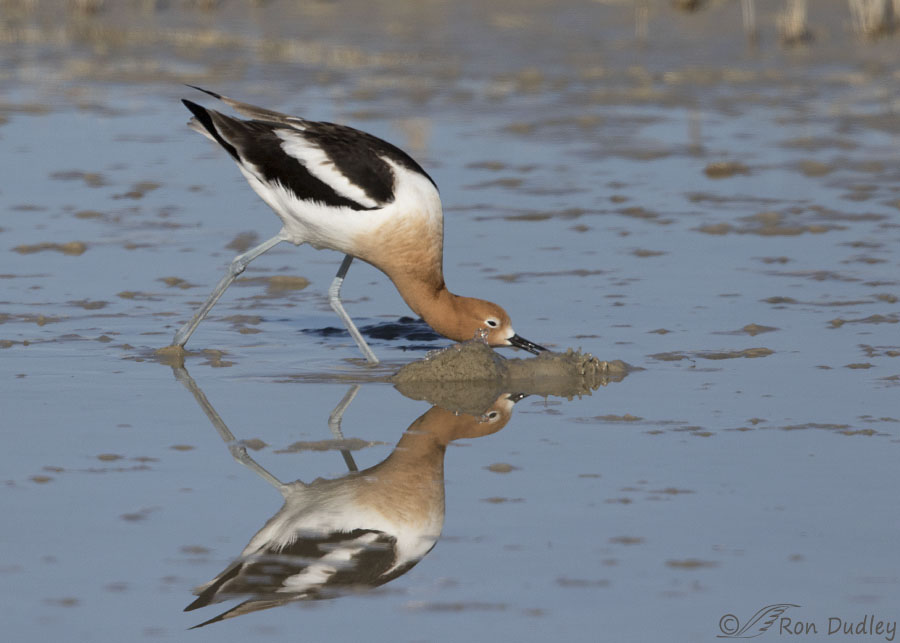
1/6400, f/6.3, ISO 400, Canon 7D Mark II, Canon EF 500mm f/4L IS II USM + EF 1.4 III Extender, not baited, set up or called in
I don’t precisely fathom how Lateral Scything actually aids in prey capture but apparently it works because several of the avocets were using it successfully. Anyone who has ever used a scythe to cut tall grass or grain (or seen it done) would understand how this feeding technique acquired its name.
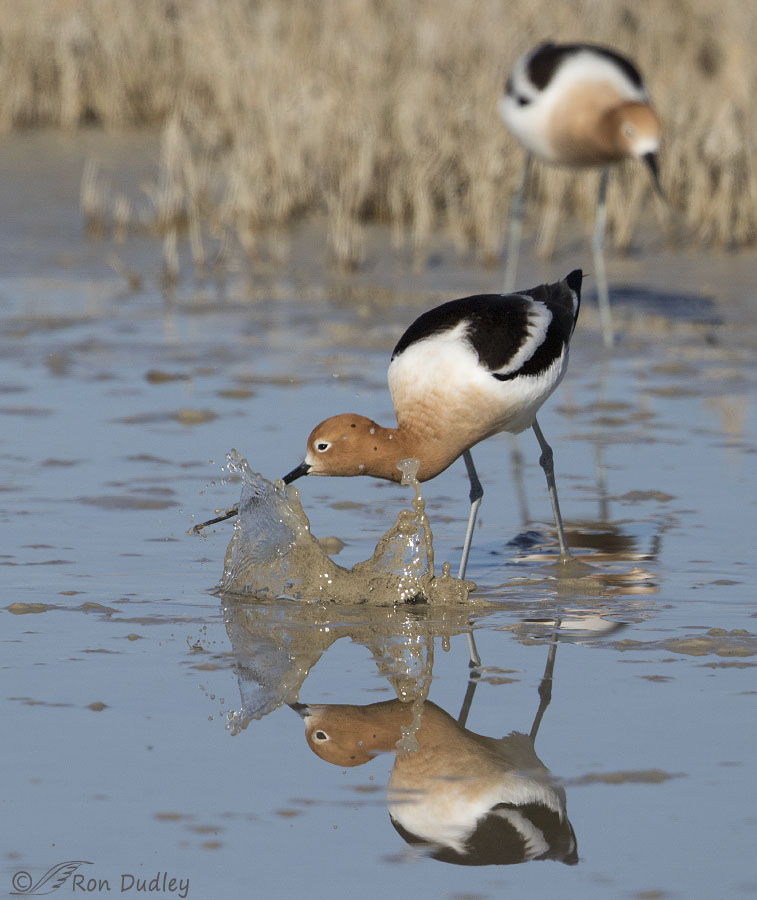
1/5000, f/6.3, ISO 400, Canon 7D Mark II, Canon EF 500mm f/4L IS II USM + EF 1.4 III Extender, not baited, set up or called in
They’re very precise while using this technique, always taking a single step between each swipe of the bill and the swipe always moves in the direction of the leading foot (as you’ll see if you review the previous images).
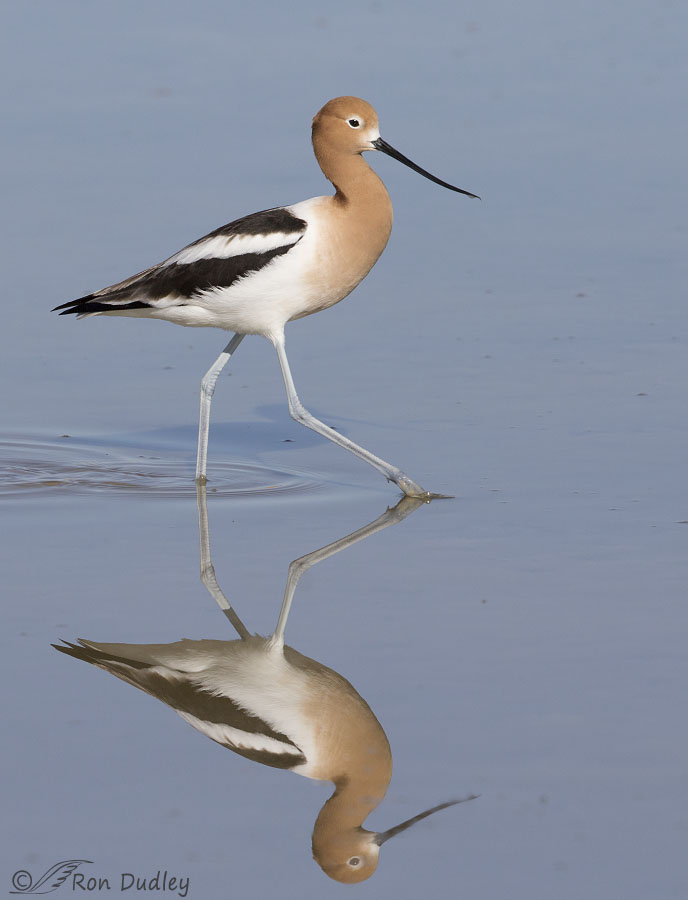
1/2500, f/6.3, ISO 250, Canon 7D Mark II, Canon EF 500mm f/4L IS II USM, not baited, set up or called in
The other attraction of my session with these avocets was the nice reflections provided by some of the relatively clear and smooth water. I think reflections can be visually interesting, although it can be a challenge to photograph them well because of composition and rotation issues (avoiding cutting off parts of the bird or reflection and getting the reflection exactly vertical to the bird).
If you’re not a fan of vertical compositions…
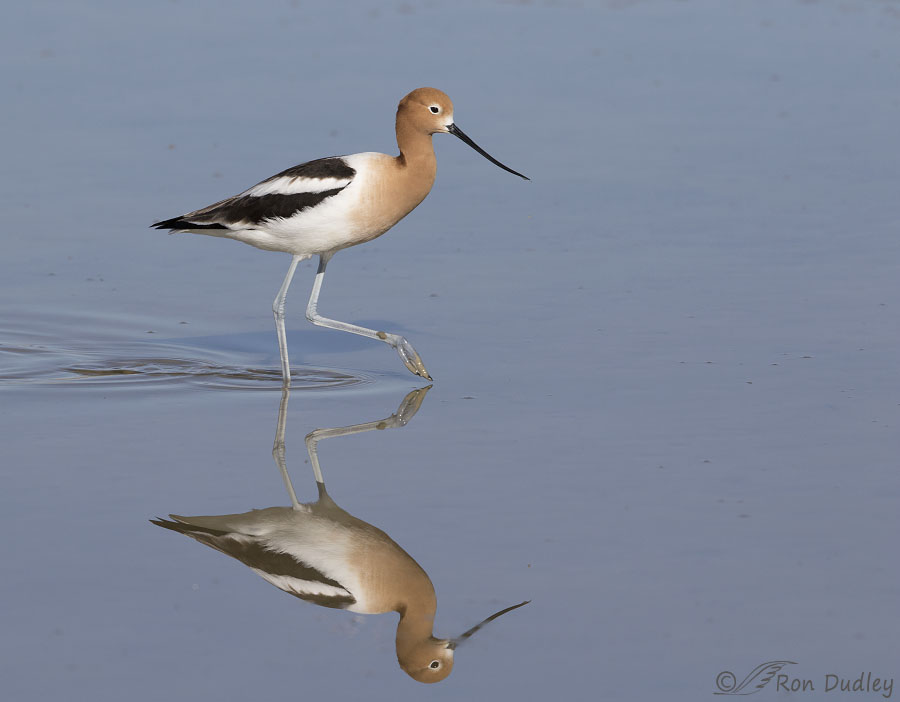
1/2500, f/6.3, ISO 250, Canon 7D Mark II, Canon EF 500mm f/4L IS II USM, not baited, set up or called in
here’s a horizontal composition of the same bird two frames after the previous one. I like the daintiness of that lifted foot about to enter the water.
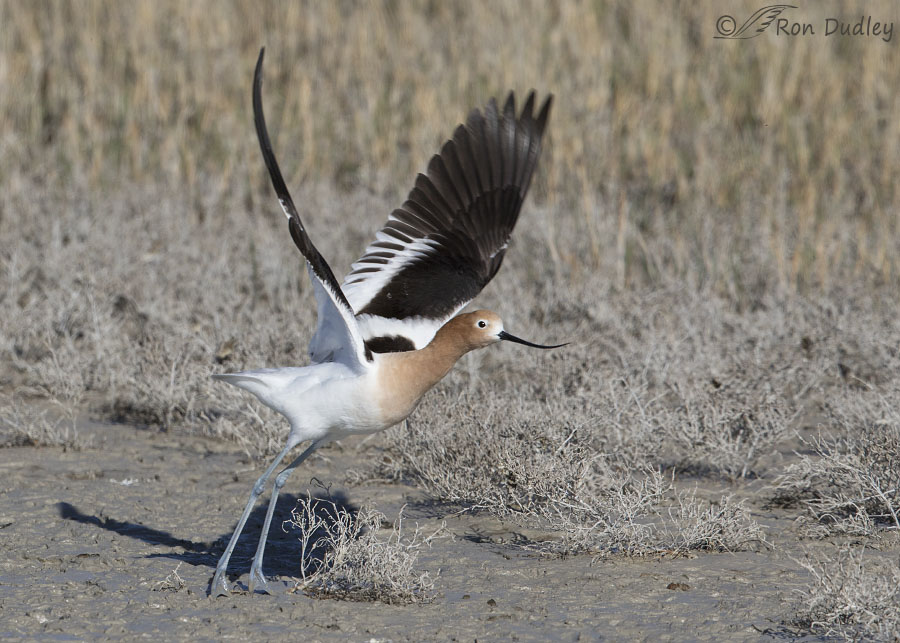
1/3200, f/6.3, ISO 250, Canon 7D Mark II, Canon EF 500mm f/4L IS II USM, not baited, set up or called in
I caught one avocet at takeoff. The setting may not be pretty but I like the dynamic pose and I’m exceptionally fond of the slight head turn providing near-perfect eye contact.
One thing struck me yesterday morning, something I’m always reminded of this time of year. It was only 9:12 AM when this photo was taken but notice from the bird’s shadow how high the sun is in the sky already. With the sun that high it becomes increasingly difficult to get any light in the eye (catch lights) and light becomes harsh as it casts deep and featureless shadows. In winter with the sun much lower in the sky I could probably be shooting until about 11 AM before light becomes this harsh and catch lights so difficult to obtain.
Just one more thing all of us bird photographers should be thinking about when planning our photo excursions.
Ron


Ron Dudley, Your photos are stunningly perfect. You know how to truly capture the unique aspects and intriguing behavior of birds. Keep up with the wonderful work!
It does my heart good to see Avocets again, especially with the reflections.
The scything feeding is really neat. I watched these birds as a beginning birder in AZ and was just happy to ID them.
I have used a scythe to cut hay and always cut the same way with the same leg forward. Avocet bills must not be as one-sided as human scythes.
“I have used a scythe to cut hay and always cut the same way with the same leg forward”
That’s an interesting observation, Pam. I’ve used a scythe to cut tall grass (just for fun to see what it was like) but I don’t remember my technique. I was just lucky to avoid cutting off a toe or two…
Outstanding Ron. Just back from three days with the grand kids in Orange County. Love Avocets – beautiful birds and beautiful pictures – and with the reflections even better.
Everett Sanborn
Prescott AZ
Thank you, Everett.
Those reflections are AMAZING.
Yet another brilliant series to start my day on. And it is 5.30 now (I am running late) and still pitch dark. The birds are starting up though. Loudly. We have some very beautiful birds but few songsters.
Thanks, EC. I’m pretty fond of those reflections too.
Sounds like your birds make up for their lack of beautiful songs with their spectacular plumage (at least in many cases).
Definitely NOT musical. As witness this young corella whinging for food. A very short video I took last week can be found here.
That bird doesn’t “sing” any better than I do! Is that the best it can muster?
That noise goes on and on and on until a parent feeds it. And then it starts again. And as an adult it shrieks.
What a splendid series, Ron. I can’t even pick a favorite of the bunch. All of them delight me soul.
My soul is also delighted by the hatch of TWO little fuzzball bobbleheads on the Cornell redtail hawk nest. A third will be hatching soon, but these littlw goobers are just glorious! Baby redtails! Yes, life IS good! For those interested, you can see the nest up close and personal at http://cams.allaboutbirds.org/channel/16/Red-tailed_Hawks/
Thanks you so much for that link Laura. Thank you and drat you. I suspect that quite a lot of time will be spent visiting.
What can I say Ron? Baby redtails ae brutally cute! And this fuzzball bobblehead stage is so far beyond cute as to be ridiculous! I hear the third is making its way out of the shell as we speak! I gotta get all the software loaded today so I can moderate chat again!
Thanks, Laura. Looks like a windy day at the Cornell nest.
Not Arizona windy, but windy. Aren’t they just gorgeous? And BR is an attentive and nurturing mom. That said, she doesn’t tolerate bad behavior! Stink eye is REAL
Marvelous shots of a beautiful species, Ron! There is so much to love about this series! You already know how thrilled I am to see interesting splash patterns (yay for the coolamatious properties of water!). Plus, you even got catch lights in the REFLECTIONS — how do you DO that? As Dick says, VBG.
I managed to catch one of the pair hanging out on the roof yesterday and it was indeed a Mourning Dove and not a Eurasian interloper, which made me happy. Must admit, I’m a leetle jelly of your vantage point from your computer, though.
And I’ll “ditto” Dick on the water thing. Gotta have my ocean! I feel so lucky to have the best of all worlds though — a 5-minute walk brings me to a river, the same in the opposite direction gives me a view of the mountains, and less than 10 minutes in the car will deposit my fanny on a sandy beach. As Mia says, “Life is good!”
“Plus, you even got catch lights in the REFLECTIONS”
Good eye, Marty. Most folks don’t even notice stuff like that.
For the entire morning the male dove has been bringing nesting material to his mate as she sits on the presumed eggs. All I have to do to see them is turn my head to my left while I’m at the computer and there they are – just a few feet away. There’s no leaves on the tree yet and the sun just hit the nest a little while ago and that must be the signal to the male to stop bringing nesting material. The same thing happened yesterday.
Oops, the female just left the nest so I stood up on my desk to look at the eggs but I can’t see any. She must be just practicing her incubation skills…
Any possibility of getting a shot or two of them? Or should I just come and camp out in your computer room?
I’ve been trying to figure out how to take a few shots without disturbing them, Marty. I may have to shoot through my window and the view off the nest isn’t completely clear of branches but I suspect I’ll do it one way or another. Stay tuned…
What a spectacular series Ron! Thanks for sharing!
Charlotte
Thank you, Charlotte.
Spectacular series. I appreciate our latest weather as well even not shooting pictures. Those reflections are wonderful and the information you share is great.
Thanks very much, Betty.
Just when I think I have a favorite.. and I wake to this beauty
 ). I’m looking forward to discovering some new birds
). I’m looking forward to discovering some new birds
Yesterday I arrived in Prescott AZ (maybe I’ll run into Everett
Have a great day
Thanks, Diana. Say hello to Everett for me if your paths cross.
A besutiful series! Love the reflections and the strutting in 6 and 7, but favorite is the last…love the detsil in the fling of the wings and the forward thrust of take off….
That last photo is also my favorite, Patty. I’ve found quality avocet takeoff and flight shots to be very difficult to get.
Absolutely fantastic images Ron, beautiful! My first Avocets were in North Dakota where there was a large nesting colony a truly wonderful experience. These shots of their walk-about and feeding behavior, the clarity and sharpness is terrific. Our weather has also been superb for the last three days, clear bright blue sky, nonexistent air pollution, warm sun, even though the breeze is still cool. However, I don’t even come close to being successful when I’m out in the field. Weather-wize we go downhill tomorrow. Spring is a great time of year.
You’ve sure had your struggles with weather this year, Dick.
I just looked at the range map and it looks like avocets are rare in almost the entire eastern half of the country. For me not having avocets around would be almost as disconcerting as not having visible mountains. I’d be even more discombobulated than I usually am!
Yes, I feel the same way about the ocean and mountains, even though we now live in VT and just have what you westerners call hills for mountains!! One has to remember what the West suffers in weather, we Easterners will also suffer in some way. As much as I adored the West when I was there, I had to get back to the sea.
Wow, beautiful shots – I love the reflections
Thank you, Hila.
Beautiful shots, Ron. The colors of the avocet are gorgeous without being gaudy. I don’t get the scything either but apparently it works – so much for clear, smooth water when they are doing that! I love reflections and the take off shot is cool….
I love reflections and the take off shot is cool….  Yes, the sun is “getting up early” now – robins really announce it here….
Yes, the sun is “getting up early” now – robins really announce it here….
Thanks Judy. Our robins start up soon after 4 AM and they really put their hearts and souls into their singing. I’m glad I’m a very early riser or my sleep would definitely be interrupted.
As I type this I’m watching Mourning Doves on their nest less than 6′ away on the other side of my window. What a wonderful diversion!